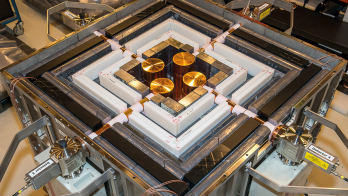by David Caldwell (ed.), Springer-Verlag. ISBN 3540410023, €79.95, £56.00.
When, almost 70 years ago, Wolfgang Pauli wrote “I have done a terrible thing, I have postulated a particle that cannot be detected,” he could not have anticipated that even now that particle, albeit detected, would continue to be the most elusive, and also the most astonishing, paradoxical and intriguing of elementary objects. We now know that it appears as (at least) three different species, possibly some of them massive, all uncharged, spinning and blind to strong interactions, and all playing the most crucial role in modern theories of the history and structure of the universe – from the smallest to the largest scales.
Indeed, few things in recent years have had as much of an impact on our view of particle physics as the recent impressive developments in neutrino physics. Experiments in this field are challenging due to the very small neutrino interaction cross-section. As Haim Harari put it: “Neutrino physics is largely an art of learning a great deal by observing nothing.” Today, new technologies and ideas have allowed us to conceive projects that may soon bring us to a much better understanding or even to a solution of the neutrino puzzle. Neutrino physics, interplaying between elementary particles and astrophysics, is currently one of the hottest subjects in physics.
The fast development of neutrino physics is – paradoxically – a reason for the small number of textbooks on the subject. Proceedings of conferences and schools are too advanced and detailed, and thus do not make up this deficiency, while standard textbooks on particle physics cannot afford to expand the subject of neutrinos. We are therefore left with a “literature hole”, a hole that is well known to graduate and postgraduate university teachers. This book, edited by David Caldwell, seems to meet these needs. It comprises a set of purpose-written, up-to-date, advanced reviews, which also offer a comprehensive view of the field – a rare but fundamental feature of a textbook – and it is aimed at both specialists and beginners.
The book begins with a concise history of neutrino physics, and is followed by a theoretical discussion of the nature of massive neutrinos. The ensuing chapters review our experimental knowledge, interleaved with a guiding theoretical framework: measurements of the neutrino masses, their flux from the Sun and the atmosphere, studies of neutrinos at reactors and accelerators, and finally double beta decay searches. The next two chapters contain phenomenological and theoretical interpretations of this empirical knowledge, and the last three chapters refer to cosmological scales and review the neutrino’s role in supernovae, in the early universe and finally in astronomy. Each chapter starts with a very good introduction and closes with a superb summary. Reference lists, compiled separately for each chapter, are extensive and up-to-date until the time the book was edited. They often contain popular and review articles.
The authors, one of whom is the editor, are recognized authorities on the topic of each chapter. The only surprise is their geographic bias: all 16 are from the United States and six of them come from California. A newcomer to the field may suspect that neutrino physics blossoms mainly along the west coast of America. The important role played by the neutrino experimental communities in Japan and Europe should have been better reflected in the choice of book contributors.
A more detailed presentation of forthcoming experiments and facilities, such as MINOS, ICARUS, OPERA, and neutrino factories, could have been included in the book. It is also unfortunate that the traditional role of neutrinos as probes of the structure of matter and interactions was completely neglected. The editor is aware of this shortcoming and states: “While they [neutrinos] have been important tools for studying particle properties, such as structure functions and the nature of weak interactions, at present this is not the thrust of most research and hence is not covered in this book.” While this is indisputably true, a short account of those efforts could have been given for completeness; after all they are still being undertaken, for example in the CCFR and NuTeV measurements of ν(νbar)-nucleon cross-sections. An appendix with Web addresses for databases or for websites where the reader can find updated or more detailed information would also be useful.
The book appears to have been carefully proofread, but the index is surprisingly poor. The names of future experiments and facilities discussed in the text are missing and some of the page numbers are wrong.
Most of the book was completed before the results of the SNO experiment were published in mid-2001, but because of their anticipated importance publication was delayed so that the results could be summarized in an addendum. Since then, KamLAND has confirmed the disappearance of the electron antineutrinos. There is always a risk that reviews have a short life-time, especially now in neutrino physics as it is developing rapidly. However, this book should be useful for a long time yet, both as a reference and a textbook, due to its comprehensive content, clear logic in ordering the material, and extremely good oversight of most aspects of neutrino physics.









